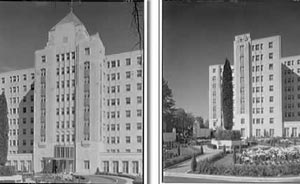talking history | syllabi | students | teachers | puzzle | about us
Washington As It Was: Photographs by Theodor Horydczak, 1923–1959
http://memory.loc.gov/ammem/collections/horydczak/
Created and maintained by the Prints and Photographs Division, Library of Congress, Washington, D.C.
Reviewed March 27, 2005.
From the early 1920s until 1959, the photographer Theodor Horydczak produced tens of thousands of prints, transparencies, and negatives, almost all of them black and white. After his retirement, the Library of Congress acquired them and, in 1996, posted digital versions of 14,350 of those images as this American Memory collection.
Horydczak was an expert craftsman, and as a commercial photographer he recorded business subjects that complement more famous journalistic photographs of the middle twentieth century: the social documentaries of Dorothea Lange, or the breaking news of Robert Capa. We see doctors examining patients, new buildings rising (Horydczak’s perspective-corrected architectural views are particularly good), and all manner of merchandise displayed in store windows or the photographer’s studio. Naturally, Horydczak’s home town of Washington, D.C., is particularly well represented, but he ranged as far as Canada and Europe.

Horydczak’s photograph of the Kennedy-Warren apartment house is well composed,
but the digital version blurs architectural and landscaping details.
Unfortunately, the site does not live up to its promise. Almost all of the images (even those of clearly identifiable events) are dated “ca. 1920–ca. 1950,” making it hard to understand them in their historical context. A list of more than 1,100 alphabetized subject headings displays the range of Horydczak’s work—drugstores, drum majors, ducks, dunes, dwellings—but is not organized into any taxonomy. Thus, one exercise on the site’s associated learning page proposes that “students might be asked to assess labor/management relations in the 1930s” by searching for images of miners, but, since there is no top-level category such as “labor” or “occupations,” a student who wanted to find images of other workers would have to scan all 1,100 subject headings. And since even the miner pictures lack dates, identifying images of the 1930s is impossible.
More significant than the troubled indexing is the quality of the images, which is quite poor compared to newer American Memory collections. The low resolution and low contrast is most noticeable in images with text, often unreadable, and in Horydczak’s architectural work, in which details disappear. The cause is the relatively primitive scanning technology of the late 1980s, when a digital image of 560 pixels on a side was considered adequate. (More recent projects have scanned photographs at a resolution of 3,000 to 5,000 pixels on the longest side.) Such low resolution diminishes the value of the photographs for classroom analysis, presentations, and especially publications.
The Web site notes that this project grew out of an attempt to preserve photographic images held on deteriorating negatives, and the library should be applauded for this effort. But preservation and presentation are different things, and a few hundred images, carefully cataloged and scanned to current standards, would be more useful to most users than the 14,000 murky images now online.
Zachary M. Schrag
George Mason University
Fairfax, Virginia
